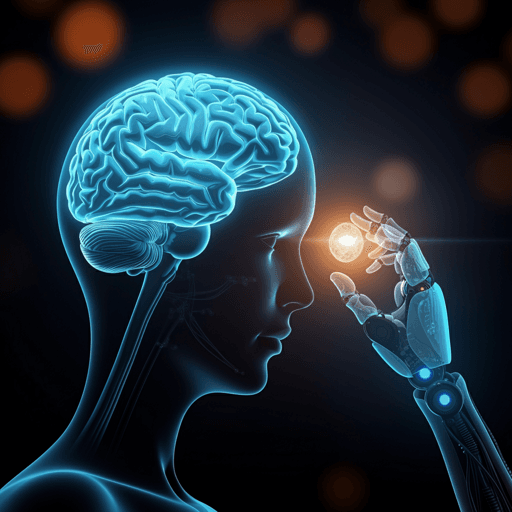
Medicine and Health
The ReHand-BCI trial: a randomized controlled trial of a brain-computer interface for upper extremity stroke neurorehabilitation
J. Cantillo-negrete, M. E. Rodríguez-garcía, et al.
A randomized controlled trial evaluated the ReHand-BCI closed-loop system using a robotic hand orthosis for stroke rehabilitation, reporting improved upper-extremity function and significant ARAT gains in the BCI group, with trends toward ipsilesional cortical and corticospinal recovery. This research was conducted by Authors present in <Authors> tag.
~3 min • Beginner • English
Introduction
Stroke is a leading cause of disability worldwide, with upper extremity hemiparesis severely limiting activities of daily living. Conventional rehabilitation often leaves 60% of patients with severe upper limb paralysis unable to use the affected limb functionally after 6 months. BCI systems decode patients’ motor intention (MI) to control external devices, commonly using EEG, and their closed-loop feedback is hypothesized to promote neuroplasticity. Prior trials combining BCI with robotic feedback report promising clinical outcomes, yet the mechanisms of recovery and differential effects versus robotic therapy without BCI remain unclear, and more controlled evidence is needed. This ReHand-BCI clinical trial compares a BCI-controlled robotic hand orthosis to a sham-BCI (random activation) across 30 sessions, measuring clinical and multi-modal neuroplasticity outcomes (EEG, fMRI, DTI, TMS). The hypothesis was that the experimental group would show greater upper extremity functional recovery, stronger ipsilesional cortical activity, higher ipsilesional corticospinal tract integrity, and greater corticospinal excitability than the control group.
Literature Review
Meta-analyses and controlled trials indicate BCI with robotic feedback can improve upper limb function post-stroke (Cervera et al., López-Larraz et al., Mansour et al.), but efficacy versus robot-only or sham remains debated, with some analyses reporting limited intergroup differences, potentially due to small samples and both modalities engaging motor systems (Qu et al., 2024). Ramos-Murguialday et al. (2013) assessed BCI with hand robotics and sham-BCI including fMRI, showing neuroplasticity-related changes. Studies highlight neuroimaging (fMRI) and diffusion imaging (DTI) for understanding recovery mechanisms, suggesting shifts toward ipsilesional dominance and white matter remodeling in corticospinal tracts are linked to motor improvement. Few BCI trials have concurrently measured EEG laterality, fMRI laterality, DTI rFA, and TMS-based corticospinal excitability.
Methodology
Design: Single-center, triple-blinded randomized controlled clinical trial at the National Institute of Rehabilitation Luis Guillermo Ibarra Ibarra (protocol 25/19 AC), adhering to the Declaration of Helsinki; informed consent obtained; registered at ClinicalTrials.gov (NCT04724824). Blinding: therapists delivering sessions, outcome assessors/statisticians, and participants were blinded to group allocation. Randomization: block randomization (1:1) via Excel. Planned sample: 15 EG and 15 CG. Participants: Adults (>18) with first ischemic or hemorrhagic stroke (3–24 months post-onset), right-handed pre-stroke, diagnosed hand paresis (Motricity Index 0–22), normal/corrected vision, mild or less cognitive impairments by NEUROPSI, and no other neurological diseases. Exclusions included severe spasticity (Modified Ashworth >2), severe aphasia/depression/attention deficits, incompatible MRI implants, and medications interfering with recovery or cognition. Interventions: 30 sessions over 6 weeks (5 per week). Each session comprised 80 trials (4 runs × 20). Trial structure: 4 s rest fixation; beep at 3 s; at 4 s, 1.5 s arrow cue to commence affected-hand MI; 3.5 s black screen maintaining MI; extension phase (9–14 s) if flexion occurred; 4–6 s blue screen inter-trial rest. EG (BCI): robotic orthosis flexion at 25% max displacement (~1.38 cm) triggered when online classifier detected MI in any of four 1-s windows during the MI period (max four flexions per trial). CG (sham-BCI): orthosis activated randomly during MI with 55–85% probability per run, independent of MI detection. ReHand-BCI system: EEG acquisition with 16 active g.LadyBird electrodes at motor-related 10–10 positions (F3/FC3/C5/C3/C1/CP3/P3/FCz/Cz/F4/FC4/C6/C4/C2/CP4/P4); reference right earlobe, ground AFz; g.USBamp at 256 Hz (24-bit). Processing: calibration (offline) used prior session EEG (or baseline for first session); filter bank (8–12, 12–16, 16–20, 20–24, 24–28, 28–32 Hz) and 60 Hz notch; CSP features extracted; feature selection via Particle Swarm Optimization; LDA classifier trained; online classification of 1-s windows as MI vs rest. Implementation in MATLAB on Dell Precision 5820; robotic hand orthosis communicated via Bluetooth. Outcomes: Primary—FMA-UE and ARAT. Secondary—EEG laterality coefficient (LC) in alpha/beta during affected-hand MI and unaffected-hand movement; fMRI laterality index (LI) during tasks; DTI ratio of fractional anisotropy (rFA) between ipsilesional and contralesional CST; TMS motor-evoked potentials (MEP) amplitudes and resting motor thresholds in ipsilesional/contralesional hemispheres at 100%, 120%, 140% RMT; classification accuracy across sessions. Assessment schedule: baseline (T0), mid-intervention (T1, after 15 sessions), post-treatment (T2, after 30 sessions), and follow-up at ~6 months post-baseline (T3). Between T0–T2, upper limb conventional therapy was withheld; lower limb and language therapies allowed; T2–T3 conventional therapy unrestricted. EEG LC computation: 32-channel recordings (added F1/F2/FC5/FC6/FC1/FC2/CP5/CP6/CP1/CP2/P1/P2/Fpz/Fz/CPz/Pz); preprocessing with 7 Hz high-pass, 35 Hz low-pass, 60 Hz notch; ICA denoising and common average reference; wavelet power (8–30 Hz) and sERD/sERS via bootstrap; LC = (sERD_IH − sERD_CH)/(sERD_IH + sERD_CH) over motor-area pairs. MRI LI: 3T Philips Ingenia; T1w, two block-design fMRI sequences (unaffected-hand movement, affected-hand MI), DTI (15 directions, b=800 s/mm²); preprocessing in FSL; GLM with motion/outlier regressors; LI = (sum positive z in IH ROIs − sum positive z in CH ROIs)/(sum positive z in IH + CH) using AAL3 motor ROIs with cerebellar decussation accounted. DTI rFA: FA maps registered to MNI; CST masks (JHU atlas) inverse-registered; rFA = mean FA_IH / mean FA_CH. TMS: Magstim Rapid², figure-of-eight coil; MEPs from first dorsal interosseous; adaptive RMT; 30 MEPs each at 100%, 120%, 140% RMT per hemisphere; automatic peak-to-peak amplitude extraction. Statistics: nonparametric tests (Mann–Whitney U for intergroup, Friedman with Bonferroni post hoc for intragroup); effect sizes r (Pearson’s) and Kendall’s W; BCI accuracy compared by two-sample t-test with Hedges-corrected Cohen’s d; alpha 0.05; SPSS v30.
Key Findings
- Enrollment and analysis: 23 randomized; final analysis EG n=10, CG n=9; no adverse events. One CG dropout; two EG missing MRI due to technical issues. - Primary outcomes: FMA-UE—both groups significantly improved intragroup. EG median increased from 24.5 [20, 36] (T0) to 28 [23, 43] (T2) and 29 [25, 44] (T3). CG from 26 [16, 37.5] (T0) to 34 [17.3, 46.5] (T2) and 32 [16.8, 52] (T3). No significant intergroup differences at any timepoint; effect sizes small. ARAT—EG showed significant gains at T2 (20 [7, 36]) vs T0 (8.5 [5, 26]) and at T3 (15 [2.5, 40.8]) vs T0; CG showed significant gain only at T3 (22 [2.5, 47.3]) vs T0 (3 [1.8, 30.5]). No significant intergroup differences; small effect sizes. - Secondary outcomes: LC (EEG) and LI (fMRI) showed no significant intergroup or intragroup differences; EG alpha LC during affected-hand MI trended toward more balanced hemispheric activity (closer to 0) at T2, returning toward contralesional dominance at T3. rFA (DTI): EG showed a significant Friedman test (p=0.045, W=0.268) but post hoc comparisons were non-significant after correction; median rFA tended to be higher across sessions in EG, indicating increased ipsilesional CST integrity relative to contralesional. CG rFA changes were not significant (p=0.068). - TMS: MEPs measurable in approximately half of participants ipsilesionally (EG: 5 at T0/T2, 4 at T3; CG: 6 at T0/T2, 4 at T3). Median MEP amplitudes exceeded 50 μV. Amplitudes increased with higher stimulation intensity (100% to 140% RMT). Ipsilesional hemisphere showed increased excitability post-treatment (higher amplitudes at 120% and 140% RMT) in both groups, persisting at follow-up primarily in EG; contralesional hemisphere amplitudes at 140% RMT were higher at T2 in EG while lowest at T2 in CG. - BCI performance: Mean classification accuracy EG 67.3% ± 8.97% vs CG perceived 69.28% ± 4.1%; no significant difference (p=0.557; d=−0.263).
Discussion
Both BCI and sham-BCI interventions produced clinically meaningful improvements in upper limb sensorimotor function (FMA-UE) and functional performance (ARAT), with stronger post-treatment and sustained functional gains in the experimental group. Despite the lack of significant intergroup differences, trends indicated that closed-loop BCI may preferentially enhance ipsilesional cortical activity and ipsilesional corticospinal tract integrity (rFA, TMS), mechanisms associated with better motor recovery. The absence of significant differences likely reflects limited statistical power and the capacity of both robotic interventions (with and without true BCI control) to engage motor networks. TMS data suggest enhanced ipsilesional and contralesional corticospinal excitability during BCI, consistent with compensatory neuroplasticity especially in patients with severely affected CST. The multi-modal physiological assessment supports the concept that closed-loop feedback can shape functional and structural neuroplastic changes relevant to recovery, even if clinical scales do not show between-group separation in a small sample.
Conclusion
A 30-session, triple-blinded randomized trial of the ReHand-BCI system demonstrated clinically meaningful improvements in upper extremity motor function in both BCI and sham-BCI groups, with a tendency for greater functional performance gains and more pronounced ipsilesional neuroplastic changes in the BCI group. This is the first controlled BCI trial to concurrently evaluate EEG laterality, fMRI laterality, DTI-based CST integrity, and TMS excitability over a long intervention and extended follow-up, providing new insights into the neuroplasticity underpinning BCI-based rehabilitation. While intergroup differences were not statistically significant, likely due to limited sample size, findings suggest closed-loop BCI may confer advantages in promoting ipsilesional hemispheric dominance and CST integrity. Future research should increase sample size, stratify patients by lesion characteristics and impairment severity, and explore dosing and personalized therapy intensity to optimize BCI-mediated recovery.
Limitations
Primary limitation was the reduced sample size (EG n=10, CG n=9), underpowering detection of expected medium between-group effects; funding constraints halted recruitment short of the 30 planned participants. Heterogeneity in lesion location (cortical, subcortical, cortical–subcortical) and stroke stage (late subacute vs chronic) may have introduced variability in recovery trajectories. TMS assessments were limited by absent measurable ipsilesional MEPs in nearly half of participants and device output constraints, reducing analyzable data. Technical issues prevented complete MRI acquisition in two EG participants. Although upper limb conventional therapy was withheld during the intervention, post-intervention therapies were not controlled before follow-up, potentially confounding long-term outcomes.
Related Publications
Explore these studies to deepen your understanding of the subject.







